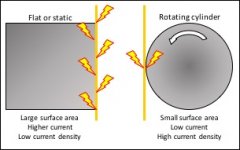Hi Marcus and Zahnrad,
Thanks for your input and you are both correct;
there is virtually no canned technology available for turn and burn applications.
I touched on this in
"Turn and Burn Explained" in the Spring issue of 2013. After the rough cuts called "slabbing" are completed, there are no suggested settings from any OEM for rotary machining. This is because of the minuscule amount of surface area engaged compared to any straight-walled cut as shown in the diagram. Following the EDM rule of; "Area = Amperage", and with almost
zero surface area engaged, this makes creating generator and servo settings a shot-in-the-dark.
If anyone has other suggestions or experience on the topic of "settings", I'll run with it if I can, but I suspect this aspect of turn and burn will be quite difficult to document and will probably remain a "cut and try" challenge.

With the picture in view, I'll use this opportunity to expand a bit upon the direction of rotation. In this example, CCW rotation will effectively
decrease the actual wire speed, while CW rotation will effectively
increase wire speed. This directional choice and the speed of part rotation will broaden your wire speed range without changing the true wire speed at the control. However, without doing a
lot of math, recording the
true wire speed for documentation (future settings) would be difficult.
Except for roughing,
nothing about rotary machining is easy. Just ask anyone here who has already slogged through this the hard way. From those of you who
have done it the hard way, I'd appreciate your guidance if this subject can be properly addressed. Personally, I suspect that this is probably too large a study for a periodical such as EDM Today. To give you an idea of how difficult this would be (and despite the small niche-market of rotary machining in EDM), there is no EDM builder (even with all of their knowledge and resources), who has developed (let alone published), this technology for their rotary-machining customers.
Which brings us back to the main reason for your suggestions, thanks.
Tough subject... anyone else?
Bud Guitrau





 Maybe with one of those large titanium cylindrical parts as an example piece?
Maybe with one of those large titanium cylindrical parts as an example piece?  .)
.)